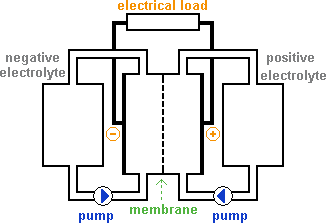
Many of us are feeling that this generation has passed on a heavy burden to our kids especially regarding the ever increasing energy needs of society. It's not all doom and gloom however, the Vanadium Battery might just return a little spring to your step and a bigger smile on your face when you next see your grand kids.

A new mass energy storage technology is on the cusp of entering mainstream society. The Japanese are currently using it on a grand scale, the Canadians have comprehensively evaluated it and soon Australians will have the opportunity to replace their old lead-acid batteries with a Vanadium Redox Battery alternative. There are no emissions, no disposal issues, no loss of charge, the construction materials are 'green' and the battery can be charged and discharged simultaneously. So, is the Vanadium Battery as good as it sounds and more importantly, is it the solution to our energy storage problems?
Quite simply...Yes.
The potential of this system can be easily summed up in one word: 100% recharge/discharge. Well that's slightly more than one word, but still it is an impressive group of words. I'm a little excited here, so let me back track a little and explain the importance of Vanadium Batteries to our very existence.
It has been possible for quite some time to successfully gather energy through a variety of renewable energy sources, in particular solar and wind. The main problem however, which is also true for fossil fuel energy generation, is the storage of the energy. There is no point in generating surplus uber-watts on one sunny and windy day to find the next day is still and raining and worst of all there is no power to play the new DVD of Stainless Steel Rat on your suped-up 80 inch LCD screen (sorry...just wishful thinking). If the energy cannot be stored on the day of bountiful bliss than a renewable energy system is useless.
In small scale alternative energy systems usually found in off-grid houses, lead-acid batteries are commonly used to store energy. The main problem with this storage system is that lead-acid batteries aren't too efficient. In order to obtain the most cycles possible (300-1500), the batteries are designed to only use 10% of their storage capacity - that's like only being able to use your iPod for one hour instead of the battery's 10 hour capacity. If more energy is sucked out of them, the amount of times they can be recharged and discharged is drastically shortened. Large scale power companies also have a little problem with storage.
Basically, they can't be bothered. It's cheaper for them to estimate the daily power needs of a city and make sure that they produce enough electricity to satisfy all vested interests - that usually takes the form of direct support for industry not individual consumers as many North Americans are finding out on an all too regular basis.
Because a powerhouse can't instantaneously lower or raise output, at night there is usually surplus electricity and the crazy situation occurs where it is pumped into the ground. For all the skeptics out there mumbling conspiracy theory, treehugging pinky, just look it up in any dictionary under 'colossal waste'. Which brings me back to the amazing invention of the Vanadium Battery.
This battery, as the name so intelligently suggests, uses a metal called Vanadium. The soon-to-be Nobel Prize recipients (if there is any justice in this world) from Australia and Europe, have found a substance that can store energy indefinitely. On top of all that, it is possible to use 100% of the stored energy without any side effects. The number of times the Vanadium Battery can be recharged/discharged is also a tad worrying for other battery makers (over 10,000 plus cycles), who must be searching desperately for new employment opportunities - possibly in the oil industry .

In all honesty the word 'battery' falls a little shy of an accurate description of this epoch-creating invention. In very basic terms (which is all I can manage after trying to read the manual) the Vanadium is stored in two separate containers in liquid form - one is charged with energy and one has a depleted energy charge. When new energy is gathered, non-charged Vanadium gets spinached-up and popeye's your uncle, you have lots of energy to expend on a 30 inch Cinema Display connected to 17 inch Powerbook playing Doom until your fingers hurt...um and ah all those other things that use power in a normal household, like lights, fridges, blah, blah, blah.
If you decide one day that you need a little more storage capacity, perhaps for that air-conditioner or hairdryer (for the uninitiated, the banes of lead-acid batteries), no worries, just get bigger storage tanks to hold more Vanadium and all of a sudden you have storage to spare. Try that with a lead-acid battery system.
On a final and semi-serious note (which is the best I can do after thinking about my dream Mac setup), Vanadium Batteries have profound implications for normal households that don't have an alternative energy system supplying power to their house. As Japan is demonstrating, the amount of energy that their power stations produce can be cut by 1/3 simply by storing their previously dumped excess nightly energy into huge Vanadium Batteries. This form of load-levelling can be utilised by every power station throughout the world.

So the next time your power has been cut on your desktop while you are smack in the middle of a frag-fest...or should I say, thesis...or perhaps while buying Vanadium stock on-line, remember that your saviour Vanadium is just around the corner and who knows, if all goes well, perhaps your next car might be using charged Vanadium as fuel, which has been the case for a few University of New South Wales professors on their local golf course.
written by Gavin Leiminer
::Pinnacle VRB
::VRB Power
::Pinnacle VRB
::Potential
Nobel Prize Winners-Australians
::Potential Nobel Prize
Winners-Europeans